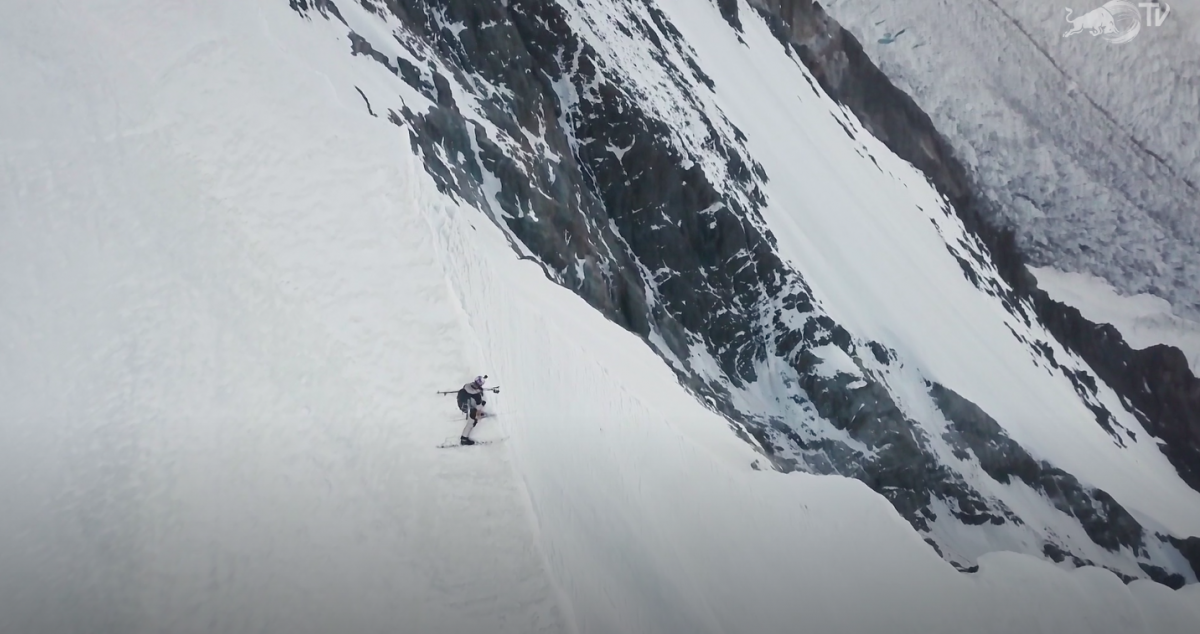
Andrzej Bargiel side slips down the slopes of K2. The Red Bull film, K2 The Impossible Descent tells the tale of his feat. Image courtesy of Red Bull media.
After sitting with my eyes glued to the screen watching Red Bull’s K2: The Impossible Descent for over an hour last night, I arrived at the following takeaways: Skimo racing is good for something. Drones can save lives. Andrzej Bargiel is the toughest ski mountaineer alive. And before you say otherwise, read on.
Located in the Karakorum Range of the Himalaya, K2 is a man eater among the 8000 meter peaks. With a summit that scratches 8611 meters (28,251 feet) it is second in hight only to Mount Everest and far more deadly. One in four people that attempt to climb the peak die, and prior to Andrzej no one had successfully skied it. The film lays out these stakes early on, but it doesn’t dwell. Accented with commentary from other members of the 8000m peak skiing club Adrian Ballinger, Hilaree Nelson and Jimmy Chin, along with Andrzej’s brother Grzegorz Bargiel who introduced him to the mountains, the film tells the gripping, at times harrowing tale of Andrzej’s ski descent from K2’s summit on July 19, 2018. Running 66 minutes long and released on Red Bull TV three days after the two-year anniversary of the descent, this documentary has everything: high stakes, gorgeous peaks, crushing setbacks, heart stopping action, drone rescues, and even (wait for it) spandex race suits.
Since the cat is out of the bag that Andrzej made it to the summit and back down again, let’s talk about how he made it: hard-nailed with no supplemental oxygen. Climbed solo above Camp 3. Skied out of the death zone in a whiteout. Utilized one 50 meter rappel (which the film omits but Lou called out in 2018.) Claimed that his feat paled in difficulty to the job his mom undertook when she birthed 11 children. Ok, I’m getting a little fangirl, but you get the point. If more ski films featured characters as humble and capable as Andrzej, the sport would be better for it.
There is one element of style, though, that’s worth a conversation: The drone. The drone, driven by Andrzej’s brother Bartek is so prominently featured in the film as to be a character and a member of the team. Bartek modified the software to enable the drone to fly above 7000. It scouts the route, it saves a stranded climber, it delivers medicine to Andrzej’s sick partner, fellow Polish mountaineer Janusz Golab, who is stuck at 7000m at Camp 3. Oh, and it captures amazing footage. The word ‘game changer’ was tossed around not once but numerous times by the commentators. There were even moments in the film where I wasn’t entirely sure who the star was: Andrzej Bargiel or the drone.
This all raised some questions for me: Does the future of big mountain ski mountaineering include — perhaps even depend — on the technical prowess of drones? Or on the physical and mental prowess that has brought ski mountaineering this far in the first place? Fodder for the peanut gallery.
In the end, Andrzej did emerge as the star as he descended successfully into basecamp, having completed what had been accepted by many as the ‘impossible descent’. The jubilation of the team is infectious and the significance of the moment inspiring. If this feat is in fact a harbinger of the next generation of ski mountaineers, as Jimmy Chin offers in the closing lines, we’re going to need to find some loftier summits, or at least, more high altitude drones.
Oh, and as for the skimo connection, just watch the film. It’s possible skimo racing might be the perfect training ground for high altitude pursuits…
Manasseh Franklin is a writer, editor and big fan of walking uphill. She has an MFA in creative nonfiction and environment and natural resources from the University of Wyoming and especially enjoys writing about glaciers. Find her other work in Alpinist, Adventure Journal, Rock and Ice, Aspen Sojourner, AFAR, Trail Runner and Western Confluence.
